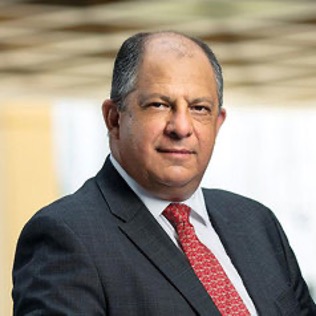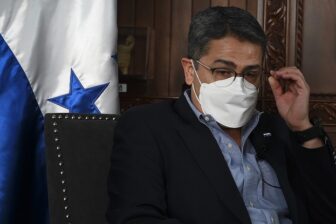Listen to a conversation with President Luis Guillermo Solís on The Americas Quarterly Podcast
During his 2020 campaign, Joe Biden pledged to develop a comprehensive rescue plan for Central America’s Northern Triangle (Guatemala, El Salvador and Honduras). President Biden, who knows Latin and Central America better than all his predecessors, remains convinced that a new $4 billion regional initiative, to be disbursed over four years, will significantly deter migration flows by addressing their root causes. His administration is now working with the 117th Congress to achieve this objective.
Biden’s determination to take a proactive role in Central America is positive, and seldom has it been more urgent. After several years of gradually declining U.S. assistance, strongly conditioned by Donald Trump’s White House to force Northern Triangle governments to take actions against migrants, the region’s recovery became uncertain once more. Although there has been significant progress in reducing what had been among the world’s highest homicide rates in the mid-2010s, the Northern Triangle continues to be one of the poorest and most troubled regions of the hemisphere. Moreover, after being severely affected by the COVID-19 pandemic and the devastating impact of two category 5 hurricanes in November 2020, Central America’s frail productive structures have been shattered.
The whole region has suffered, including the countries of Costa Rica, Panama and Belize. On average, GDP in Central America may have plunged 6% in 2020, according to the International Monetary Fund, with only a partial 3.5% recovery expected this year (the IMF includes the Dominican Republic in this grouping). Likewise, unemployment is expected to soar well beyond 10% of the workforce in many countries — in a region where as many as 70% of workers are already underemployed. The number of people living in extreme poverty, those who barely survive with $1 a day or less, is expected to increase as well. The region’s already deplorable economic standing may well slip back a decade.
Giving more U.S. money to try to bring democracy and development to Central America is not a new idea, and historically it has had mixed results. For more than half a century, different administrations have provided enormous financial and technical aid with similar objectives. From John F. Kennedy and Lyndon B. Johnson’s Alliance for Progress in the 1960s, the Kissinger Commission on Central America (1984), to the more recent Central American Security Initiative (CARSI, 2014) and the Alliance for Prosperity and the Strategy for Engagement in Central America (updated in 2017), the U.S. has spent vast resources in an attempt to support the region’s development.
During the Cold War, this support included military aid to fight the spread of communism, and governments were often dictatorships with dire human rights records. Since 1990, most U.S. assistance has gone to NGOs and civil society organizations; this aid was designed to promote programs that further economic and agricultural development, combat violence and insecurity, empower youth and women and fight corruption and bad governance. Strengthening the rule of law and the administration of justice, moreover, was frequently at the core of some of these programs.
Between 2016 and 2021, the U.S. Congress appropriated more than $3.6 billion to fund the so-called Strategy for Engagement in Central America. Congress designated these resources toward bilateral assistance programs focused on human development (economic growth and social welfare) and programs intended to improve the quality of the justice sector, prevent violence and combat gangs and transnational organized crime. For 2021 alone, Congress appropriated $505.9 million in assistance to Central America as a whole. One conclusion is clear: In recent years, the U.S. has consistently attempted to contribute (with ups and downs depending on the political context) to improve the living conditions of the people and the strength of the institutions and political systems of Central America. Biden’s plan would roughly double the amount of annual assistance going forward.
Thus, the question to ask today is not whether Central America (all of it, not just the Northern Triangle) requires more money or not. Without a doubt it certainly does, and the region will continue in need of such funding for many years to come. Nor should the discussion be limited to the amount of funding that the U.S. should provide, significant as this may be. Rather, decision-makers in Washington D.C. should consider even more complicated, troublesome questions: Why, after so many decades of systematic support by the U.S. directed at Central America’s structural challenges, has the situation in the region not significantly improved for millions of its peoples? What factors have impeded and continue to obstruct the aspirations of Central Americans who endure the hardships of lives dominated by fear, dispossession, sickness, corruption and hunger?
And above all: How can the allotments of foreign aid be disbursed under the Biden administration to ensure that they produce the highest impact, greatest social returns and most transparent administration?
Learning to spend
A more detailed study of past aid efforts helps begin to answer these questions. Throughout Democrat and Republican administrations alike, institutions that generally control and oversee U.S.-funded programs abroad, like the Government Accountability Office (GAO), as well as technical agencies such as the Congressional Research Service or the United States Agency for International Development (USAID), and even highly respected liberal and conservative think tanks influential in Washington, D.C., have identified a series of factors that explain the feeble results of U.S. programs in Central America.
Some of these factors are to be found in the isthmus itself, deeply rooted in the region’s power structures. Others result from what those controlling institutions call “lack of comprehensive monitoring and evaluation plans,” “insufficient information,” and “weak project-level assessments.” One of the most troubling aspects of the way in which U.S. aid to Central America is administered is the high level of “unexpended monies resulting from unliquidated obligations,” sometimes accumulated over several fiscal periods. In plain language: U.S. agencies have often been unable to measure the real impact of U.S.-funded programs in the Northern Triangle, while the resources designated to implement the programs have often not even been used. That was either due to the incapacity of the local partners, or because Congress and the White House have withheld the funds until certifications of their correct use have been issued by the Central American governments or other national institutions. This situation leaves allotted, but unused, funds siting in the budget.
The U.S. Department of Agriculture (USDA), for instance, allocated around $407 million to Central America between 2013 and 2018. Of this amount, about $249 million was disbursed. Yet, at the end of 2018 some $159 million remained as an “unobligated balance or unliquidated obligation.” The money was meant to provide school meals and nutritional programs for women, infants and children, training and technical assistance to improve agricultural productivity and expand markets and trade. It should have also been used to provide development assistance and emergency relief using local commodities.
It is up to the U.S. to provide answers and hopefully, solutions, to its own internal challenges hindering the real transformational capacity of the funds allocated to Central America. While inter-agency coordination efforts have improved through the years, they have been clearly insufficient. It is still necessary to streamline the priorities, budget execution, evaluation and follow-up procedures between and amongst the government agencies involved. Congress and the White House (National Security Council) must be brought into this dialogue even more, and so should U.S. embassies in the region. A frank, honest and detailed discussion of the current situation in Central America after its ransacking by COVID-19, extreme events, the worrisome political situations developing in El Salvador and Honduras, and the likelihood of the Ortega-Murillo dictatorship consolidating its rule in Nicaragua, are just some of the elements to consider in these inter-institutional policy conversations.
The bigger and deeper reasons for the limited impact of U.S. assistance, however, have to do with local factors in the four northernmost countries of Central America. Most particularly, with structural conditions which for almost 200 years have created undemocratic, unfair, repressive and opaque political systems, largely dominated by clientelism, authoritarian practices, state-sponsored violence and disrespect for the rule of law. These systems have produced very weak institutions, neglected the development of solid, public education and health frameworks, the economic and legal empowerment of women, ignored attending to the poor and extreme poor, or inhibited the existence of labor rights for the working population, particularly the indigenous and dwellers in rural areas.
On top of these factors, the existence of non-state violent actors, both common and transnational, dominating ample public spaces all the way from the “barrios” to the national territories is also a source of grave concern. So is the significant deterioration of citizens’ approval, adherence and support of democracy as the political system of choice. This relatively recent phenomenon, coupled with widespread corruption and questionable electoral practices, has exacerbated the region’s problems, and produced a steady and generalized deterioration of the governments’ credibility and legitimacy over the past two decades. In this context, the effectiveness of the newly announced Biden Initiative for the Central American Northern Triangle could be compromised once again.
Hence, it would be wise to review the record and emphasize those practices that have proven most effective. It is not possible to exclude national governments completely from the operational management of U.S. aid — that would risk, among other things, further erosion of their authority. But the path does seem to lie in including and emphasizing other, more reliable partners — particularly those from regional and national civil society organizations, as well as the private sector — to execute the funds. Recent comments by Biden administration officials suggest they are moving in this direction, and will also seek to condition funds to anti-corruption and other measures. The adoption of program areas that can provide sustainability beyond the short term is also key.
These include promoting the professional talents and the training of human resources (robust scholarship programs, for instance) and the strengthening of activities such as the ones Dr. Jill Biden has undertaken promoting STEM and STEAM programs for girls and young adult women. Support to enhance resilience before extreme events and the adaptation and mitigation of climate change should be a central part of this longer-term effort. The provision of drinking water and electricity produced by renewable energies could ease some of the pressures forcing campesinos to migrate, and simultaneously improving their health and nutrition. Equally important would be for the U.S. to provide political and financial support to uphold the rule of law through the reestablishment of multilaterally backed Justice Commissions such as CICIG. Conditional support to the Northern Triangle governments would also be justified upon the compliance with measurable progress indicators, particularly in what pertains the job markets, public security, fighting against corruption and health.
Another interesting way forward is the reactivation of the dialogue that the U.S., the European Union, Japan, South Korea and other multilateral donors successfully held on Central America in the 1990s. A comprehensive, well-coordinated assistance by the major contributors could have a positive and long-lasting impact in the region, helping align priority programs and projects, as well as focusing on key areas of interest. The return of multilateralism under Biden should facilitate such efforts — and prove very positive for other reasons as well. It is also worth asking to what extent Belize, Costa Rica and Panama should be included in both conversations about aid as well as aid itself, as part of the quest for a more stable and developed Central America.
There are no easy nor fast approaches to the Central American dilemma. Yet, one thing remains true: It is in the interest of the U.S. and the region to prevent the past from — once again — becoming prelude to the future.
—
Solís is the interim director at the Kimberly Green Latin American and Caribbean Center at Florida International University. From 2014-2018 he served as the President of the Republic of Costa Rica.








